Corrugated sink - simple and reliable connection to the
The use of a flexible corrugated tube makes it much easier to connect the sink to the sewer pipe. This is especially important in cramped conditions, when it is difficult to install conventional plastic pipes.
By itself, the installation of corrugations is simple, but there are a number of nuances, before the final choice is not superfluous to familiarize yourself with them.
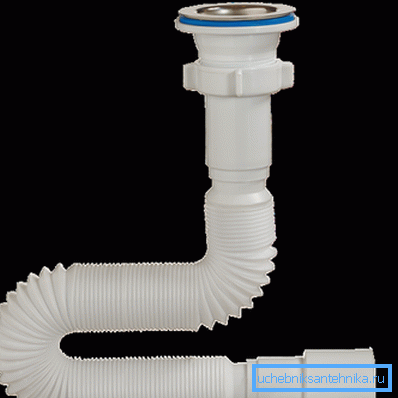
The benefits of using flutes
Connecting the sink to the sewer can be done in 2 ways. Ordinary plastic pipes can be used, and it is possible to simply connect the siphon outlet to the entrance to the sewer pipe with a corrugated pipe.
This solution has several advantages:
- corrugated under the sink due to the corrugated side wall stretches without problems, so you can not be afraid not to guess with the length of the pipe;
Note! Strongly stretch it all the same is not recommended. It must be remembered that the wall is made of rubber and does not differ in special strength, with excessive stretching its service life will be reduced.
- simplified installation process. If using conventional pipes, it is not possible to do without turns, then the corrugation allows you to immediately connect the sewer entrance to the siphon outlet;
- in cramped conditions, the use of ordinary pipes can be very complicated, corrugated analog in this case is very convenient;
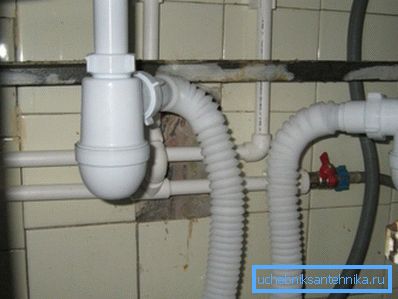
- The low price and availability also relate to the benefits - you can purchase a bottle siphon with a corrugation for connection at about 200-300 rubles in any sanitary ware store.
There are a number of drawbacks, some fairly significant:
- ribbed surface - not the best option for drainage, especially in the kitchen. In the bathroom, this does not play a special role, because only water is drained into the sewer, but in the kitchen a corrugation can quickly become clogged. This is due to the fact that in addition to water, fat passes through it and other substances that you have to deal with in the kitchen, the folds get clogged up very quickly;
- lower resistance to mechanical stress - a thin rubber wall is very easy to damage;
- the inability to use a plunger to clean a clogged sewage system, the pressure drops created by this can lead to rupture of the wall. Other methods of clogging, for example, plumbing wire, are also banned.
Details about the types and connections using corrugations
The process of connecting the sink to the sewer is very simple - a siphon is connected, and then the outlet from it is connected to the sewer pipe. The package includes sealing gaskets, so you can not worry about the tightness of connections, even when doing all the work with your own hands.
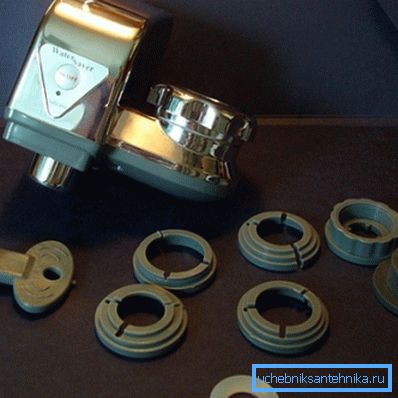
Subtleties of choice
When choosing corrugations attention should be paid to 2 points - the rigidity and condition of the walls. From this depends on the ease of installation and durability of the pipe.
As for stiffness, it all depends on the conditions of connection of the sink. If there is enough space, and the pipe does not have to bend much, then it is quite possible to take a more rigid corrugation, with a strong wall. In the arc of a large radius, it will bend without problems, and more is not needed.
Note! If you plan to buy a rigid corrugated pipe, it is better to purchase a siphon separately. To bend a rigid corrugation to obtain an S-shaped hydraulic lock is not possible.
If there is not enough free space, then an option with a thin and elastic wall will do. Such pipes can bend at almost any angle.
You also need to pay attention to the condition and size of the corrugations for the sink. The pipe wall should not have visible damage, and the bending lines should not leave worn impressions.
As for the diameter, you can find 3 options - 50, 40 and 32 mm. If the corrugation is purchased separately, then you can navigate to the diameter of the siphon drain. Although, if the diameters of the pipe and drain are different, then you can use an adapter.
Which siphon to choose
The purpose of any siphon is one thing - to prevent the penetration of unpleasant odors from the sewer into the room. This is achieved due to the fact that the water after draining overlaps the pipe and the odors do not leak through this obstacle.
Depending on the design, several types of sink siphons can be distinguished:
- siphon with corrugation for the sink - is a conventional plastic or metal bottle type. The package also includes the corrugation itself;
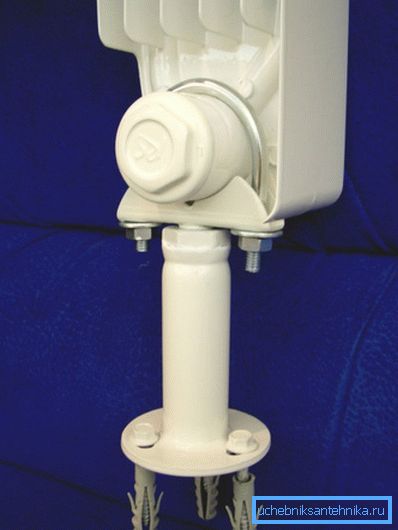
Note! Siphons of this type are quickly clogged with debris, therefore they are more suitable for a bathroom. For the kitchen is better to stay at the usual S-shaped version.
- ordinary siphon - is a curved metal or plastic tube that connects to the sewage system. Due to the S-shape in the pipe there is always a water plug;

- from flexible corrugations a simple water seal You can build it yourself, just bend it so that there remains a water bridge inside. To facilitate the task, special plastic frames are produced in which the tube is fixed after bending. Such a corrugated sink siphon can be recommended for connecting, for example, a sink in the bathroom.
Sink connection
A rather common variant is with a bottle-type siphon and a corrugated tube connecting it to the sewage system.

The scope of work includes the siphon assembly and, in fact, connecting the sink to the sewer:
- You need to start with the assembly of the siphon. In its lower part, the water pressure will be maximum, so the tightness of the installed cover is of particular importance. A fairly common, but non-critical defect is small burrs on the lid; if they are not removed before installation, they may well damage the rubber gasket;
- A rubber gasket fits into a special groove and is coated with a sealant, and the edge of the thread will not be superfluous. Then the lid is simply wound on the bottom of the case.

Note! When assembling, you do not need to screw the cover with all your might. The only thing that can be achieved with this is to break the thread. The required tightness is achieved through the use of sealant.
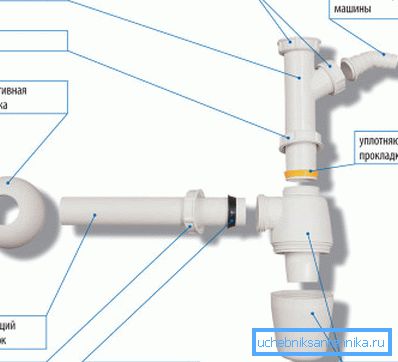
After that, you can go to the main work front, the instructions for connecting the sink will look like this:
- a union nut and a tapered rubber gasket are put on the branch pipe (it must be positioned so that there is only a few cm left up to the top of the pipe);

- After that, the pipe must be very carefully placed inside the case. In no case should he touch the bottom, otherwise the siphon will not be able to pass water through itself;
- in the sink itself, a gasket should be laid in the sink, and a metal mesh should be placed on top;

Note! The depth of the stamped depression at the bottom of the shell should be such that the decorative overlay does not rise above the bottom. Otherwise, a slight stagnation of water at the bottom is guaranteed.
- the branch pipe is connected to the sink;
- after that it remains only to connect the siphon with the sewage system. Both conventional and flexible corrugated pipes can be used for this. First install the exhaust pipe (when installing using a cap nut, rubber cone gasket and sealant). Then, using a plastic or corrugated flexible tube, the structure is connected to the sewage system;

- after that, it remains only to drain the water and observe the behavior of the joints. If the water does not leak, then everything is in order - tightness is ensured.
Note! When using corrugations it is not recommended to make horizontal sections too long, the pipe will sag and water will linger in it.
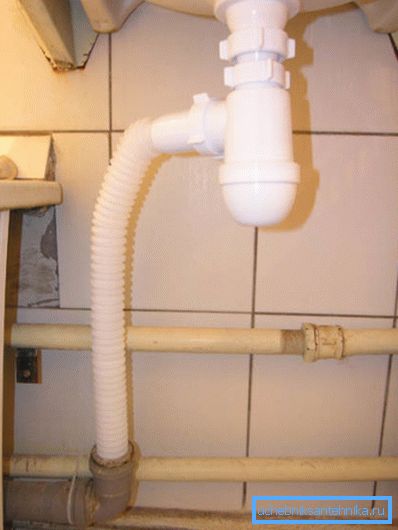
As for the connection of the whole siphon, the instruction, in general, remains the same, even simplifies a little. Only the stages of connecting the siphon to the sink and the sewage system remain.
Well, the simplest way to connect the sink to the sewer can be considered a corrugated siphon. All that is needed for this is a plastic clamp that will fix the S-shaped position of the pipe.
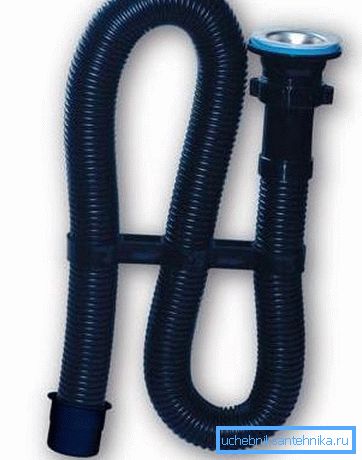
Summarizing
Corrugated pipe for the sink can significantly facilitate the process of its connection to the sewer system, especially in cramped conditions. Due to this, as well as the fact that even a novice plumber can handle the job, this type of connection is popular.
The video in this article shows in detail the process of connecting the sink to the sewage system using corrugations.